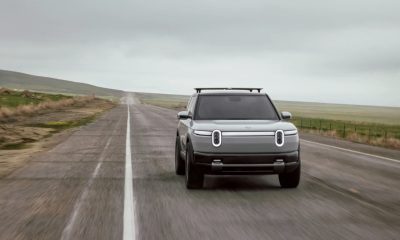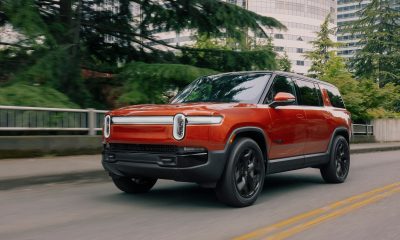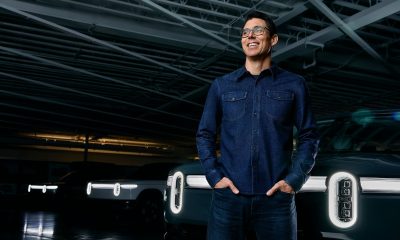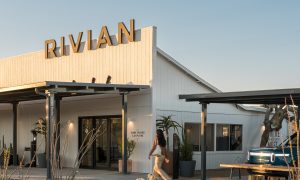

News
EXCLUSIVE: ‘Rivian wanted what Georgia had’: How the Peach State became Rivian’s $5B match
In the Northern portion of Georgia, about 45 miles East of Atlanta, a 2,000-acre slice of land is covered in beautiful trees, hosting stunning landscapes of the rural sections of the Peach State. For several years, Georgia Economic Development Department Commissioner Pat Wilson has pitched this massive piece of beautiful real estate to various automakers, with nobody willing to bring another massive vehicle manufacturing facility to the heart of the Southeastern United States. That was until Rivian came to town.
“It was the perfect company for the perfect site.”
“We considered making it an OEM site,” Wilson, who has been the Commissioner of the State of Georgia’s Economic Development Department since November 2016, told Teslarati in an exclusive interview. He showed the property to Volvo and Toyota/Mazda, among others, over the past few years, but could not come to terms with them on the land. These large-scale, mass-market automakers were unwilling to join Kia, which has a massive $1.8 billion, 2.2 million square foot factory just miles away from the Georgia-Alabama border, to bring a sizeable manufacturing plant to Georgia. It just was not the right fit.
The right fit would eventually come along. While sifting through requests from various companies who were interested in the site and ultimately coming up with no buyers, Wilson knew the right company would eventually show up to build on the land. It would not end up being a car company with a long-standing history of successful automotive manufacturing. Instead, a company known as Rivian Automotive, which just rolled its first production units off of an assembly line in Normal, Illinois, and completed its first deliveries earlier this year, was requesting information. It would end up being the peach Georgia needed to secure its single most significant investment in state history — $5 billion, to be exact. “It was the perfect company for the perfect site,” Wilson said. “Rivian wanted what Georgia had.”
Rivian will build its next EV manufacturing plant in Georgia
CEO RJ Scaringe eventually drove around the 2,000-acre site in a Rivian R1T, plotting ideas and envisioning his young and scrappy company’s second U.S.-located automotive assembly plant. It is a beautiful landscape, and it needed to be preserved. “RJ was genuinely concerned about keeping the area environmentally stable. ” Wilson said. “You only have to look at their website and read a little bit of it to see that this is a company that cares about the world and sustainability. It was important to him to keep the area in its beautiful state.”
“RJ was genuinely concerned about keeping the area environmentally stable…It was important to him to keep the area in its beautiful state.”
Rivian wanted a property with a beautiful landscape, and Wilson said the company wanted to preserve its beauty and integrate its future automotive facility into the topography, which will hit its expected employment of 7,500 people in 2028. It also did not intrude on locals or nearby residents, who gave their blessing for the Economic Development Department to offer the area to large industries. “We don’t propose sites unless we are invited to do so,” Wilson clarified. Citizens welcomed projects with open arms, which solved half of the issue. The next was selling Rivian on the idea.
Selling Scaringe: Lofty Expectations
Rivian undoubtedly had its reservations, and its elevated expectations and accelerated timeline scared off plenty of other regions that were in the running for “Project Terra.” Like other high-tech electric vehicle startups, Rivian had lofty goals to begin production shortly after construction starts. Other states and areas might not have been as willing or able as Georgia to commit to the quick turnaround Rivian and Scaringe had described. Construction will begin in Georgia in Summer 2022, with production lines ramping up in 2024. Rivian hopes to have one of its non-negotiable terms met by launching production around two years after construction crews break ground. Evidently, Speed to Market was a real need for Rivian, and it needed the right State and the right team to make it happen.
CEO & Founder of Rivian, RJ Scaringe (Photo: Rivian)
Speed and efficiency of the construction process was not the only advantage Rivian saw with the site, however. The 2,000-acre land plot that the company locked up and subsequently announced during the company’s first quarterly earnings call as a publicly-traded entity last week also has a great location that could alleviate potential supply chain concerns. Sitting in the Interstate 20 corridor, the plant will have easy access to the Port of Savannah and the State’s 5,000 miles of railway to deliver manufacturing materials quickly. This solved logistical concerns relatively quickly.
There were other concerns too, however. Georgia has one of the lowest unemployment rates in the United States, which sounds like a good thing. Department of Labor statistics listed Georgia’s unemployment rate at just 2.8% for November 2021, the fourth-lowest rate federally, following Nebraska (1.8%), Utah (2.1%), and Oklahoma (2.5%). Interestingly and nearly counterintuitively, a low unemployment rate could actually bring some large-scale companies with sizeable employment needs problems down the road, and Rivian knew that Georgia had a reputation for keeping its people employed. Governor Brian Kemp kept the State’s workforce relatively operational through the COVID-19 pandemic in 2020 and 2021. “He created structure for the State,” which ultimately kept Georgia’s people at work, eliminating widespread unemployment and furloughs, Wilson said.
Georgia committed to Rivian’s needs and essentially removed its concerns regarding employment by securing plans for a Quick Start workforce training program facility at the future automotive plant. Quick Start is a State-sponsored program created in 1967 that provides customized workforce training for expanding industries. It runs through the Georgia Technical College System and gives workers free, hands-on, in-depth training that contributes to the state’s economy. Wilson said the program essentially lets taxpayer dollars be funded back into local communities through job training. It keeps people at work, it invests back into the citizens of the State, and most importantly, it prepares them for the job they are about to start. It is a highly successful and proven program that resulted in the first car ever built at the Kia Factory in West Point being fully operational. This is an event that does not happen often, as most vehicles that roll off of production lines as prototypes in a facility’s early days are usually a result of training and are not close to production quality.
Quick Start does more than give employees comprehensive, hands-on training. It also gives Georgians the opportunity to stay in their communities and develop them. Wilson was adamant that the Quick Start program has retained indescribable amounts of talent in Georgia, keeping the State’s workforce and some of its most brilliant minds local. “It gives people a chance to help their communities, but it keeps Georgia talent in Georgia. It benefits the taxpayers because we are investing back into our people,” Wilson added.
While Rivian’s project is the most recent to enter Georgia, Wilson certainly hopes it is not the last. “I hope more EV makers come to our State,” he said. “There will be more change in the automotive industry in the next ten years than there was in the last 100. These are jobs for the future, and we are looking for them because it is generational for the State. These plants will create jobs 60 years down the road.”
I’d love to hear from you! If you have any comments, concerns, or questions, please email me at joey@teslarati.com. You can also reach me on Twitter @KlenderJoey, or if you have news tips, you can email us at tips@teslarati.com.
News
SpaceX’s Crew-11 mission targets July 31 launch amid tight ISS schedule
The flight will lift off from Launch Complex 39A at Kennedy Space Center in Florida.

NASA and SpaceX are targeting July 31 for the launch of Crew-11, the next crewed mission to the International Space Station (ISS). The flight will lift off from Launch Complex 39A at Kennedy Space Center in Florida, using the Crew Dragon Endeavour and a Falcon 9 booster.
Crew Dragon Endeavour returns
Crew-11 will be the sixth flight for Endeavour, making it SpaceX’s most experienced crew vehicle to date. According to SpaceX’s director of Dragon mission management, Sarah Walker, Endeavour has already carried 18 astronauts representing eight countries since its first mission with NASA’s Bob Behnken and Doug Hurley in 2020, as noted in an MSN report.
“This Dragon spacecraft has successfully flown 18 crew members representing eight countries to space already, starting with (NASA astronauts) Bob (Behnken) and Doug (Hurley) in 2020, when it returned human spaceflight capabilities to the United States for the first time since the shuttle retired in July of 2011,” Walker said.
For this mission, Endeavour will debut SpaceX’s upgraded drogue 3.1 parachutes, designed to further enhance reentry safety. The parachutes are part of SpaceX’s ongoing improvements to its human-rated spacecraft, and Crew-11 will serve as their first operational test.
The Falcon 9 booster supporting this launch is core B1094, which has launched in two previous Starlink missions, as well as the private Ax-4 mission on June 25, as noted in a Space.com report.
The four-members of Crew-11 are NASA astronauts Zena Cardman and Mike Fincke, as well as Japan’s Kimiya Yui and Russia’s Oleg Platonov.
Tight launch timing
Crew-11 is slated to arrive at the ISS just as NASA coordinates a sequence of missions, including the departure of Crew-10 and the arrival of SpaceX’s CRS-33 mission. NASA’s Bill Spetch emphasized the need for careful planning amid limited launch resources, noting the importance of maintaining station altitude and resupply cadence.
“Providing multiple methods for us to maintain the station altitude is critically important as we continue to operate and get the most use out of our limited launch resources that we do have. We’re really looking forward to demonstrating that capability with (CRS-33) showing up after we get through the Crew-11 and Crew-10 handover,” Spetch stated.
Lifestyle
EV fans urge Tesla to acquire Unplugged Performance for edge in fleet and security industry
Unplugged Performance has built a name for itself by producing performance upgrades for Tesla vehicles.

A growing number of Tesla enthusiasts and longtime community voices are calling on the electric vehicle maker to acquire Unplugged Performance, a California-based aftermarket company best known for tuning Tesla vehicles and developing specialized government fleet solutions under its UP.FIT division.
The idea was once considered a niche proposal among EV fans, but it is now gaining serious attention not just as a performance play but as a strategic move to deepen Tesla’s roots in the fleet and security industry.
A strategic fit
Unplugged Performance has built a name for itself by producing performance upgrades for Tesla vehicles, from track-optimized components to visual and aerodynamic upgrades. But in recent years, its UP.FIT division has pivoted toward a more functional future by outfitting Tesla vehicles like Model Ys for police, military, and government use.
That work has sparked growing calls for closer collaboration with Tesla, especially as the EV maker increasingly leans into autonomy, AI, and fleet services as core components of its next chapter.
“I posted this four years ago, but I think it’s more true now than ever,” wrote Whole Mars Catalog, a well-known Tesla investor and FSD Beta tester, on X. “Tesla should buy Unplugged. But not just as a Performance division. What they are doing with UP.FIT unlocks large government and commercial fleet purchases that can improve utilization.”
Tesla fans such as shareholder Sawyer Merritt echoed the sentiment, calling Unplugged a “great fit within Tesla.” adding, “They are literally located directly next to Tesla’s design studio in Hawthorne.”
Enabling the next wave
Supporters of the idea noted that integrating Unplugged into Tesla’s corporate structure could help accelerate the adoption of autonomous technologies in government sectors. With UP.FIT patrol cars already in use across some U.S. police departments, Tesla fans envisioned a future where self-driving Teslas could potentially revolutionize law enforcement, search-and-rescue, and public service logistics.
“Just imagine how autonomous patrol cars could transform policing and bring us into a safer future,” the veteran FSD tester wrote.
The benefits could also extend to Tesla’s existing consumer base. “They also have some incredible products in the works that I think will appeal to many ordinary Tesla drivers — not just those looking for performance or mods. Stuff that’s so good it should have come straight from the design studio next door,” Whole Mars Catalog noted.
Unplugged Performance, founded in 2013, shares not just a product vision with Tesla, but also geography. Its Hawthorne headquarters sits directly adjacent to Tesla’s design studio, and the two companies have maintained a close working relationship over the years. The aftermarket firm has long positioned itself as a “mission-aligned” partner to Tesla.
In response to the recent calls for acquisition, Unplugged Performance acknowledged the support from the community. “Our very existence is to support the Tesla mission with @UpfitTesla and @UnpluggedTesla,” Unplugged CEO Ben Schaffer posted on X. “We love working with Tesla and are grateful for the community’s support since 2013!”
News
Tesla debuts hands-free Grok AI with update 2025.26: What you need to know
All new Tesla vehicles delivered on or after July 12, 2025, will include Grok AI out of the box

Tesla has begun rolling out Grok, an in-car conversational AI assistant developed by xAI, to eligible vehicles starting July 12. The feature marks the most direct integration yet between Elon Musk’s artificial intelligence startup and Tesla’s consumer product lineup, offering drivers hands-free access to a chat-style companion while on the road.
Grok comes pre-installed on new vehicles
According to Tesla’s FAQ page for the feature, all new vehicles delivered on or after July 12, 2025, will include Grok AI out of the box. Owners of older vehicles may gain access through an over-the-air update, provided their vehicle meets a few hardware and software requirements.
Specifically, Grok is currently only supported on Tesla models equipped with an AMD infotainment processor and running vehicle software version 2025.26 and higher. Compatible models include the Model S, Model 3, Model X, Model Y, and Cybertruck. A Premium Connectivity subscription or active Wi-Fi connection is also required.
Tesla notes that additional vehicle compatibility may arrive in future software updates.
Grok’s features and limitations for now
Drivers can engage with Grok using the App Launcher or by pressing and holding the voice command button on the steering wheel. Grok is designed to answer questions and hold conversations using natural language, offering responses tailored to its chosen personality—ranging from “Storyteller” to the more eccentric “Unhinged.”
For fun, Tesla posted a demonstration of Grok likely running on “Unhinged” talking about what it would do to Optimus when they are on a date, much to the shock of the humanoid robot’s official social media account.
It should be noted, however, that Grok cannot currently issue commands to the vehicle itself, at least for now. Traditional voice commands for tasks like climate control, navigation, or media remain separate from Grok as of writing.
The feature is being released in Beta and does not require a Grok account or xAI subscription to activate, although that policy may change over time.
Grok privacy and in-car experience
Tesla emphasizes that interactions with Grok are securely processed by xAI and not linked to a user’s Tesla account or vehicle. Conversations remain anonymous unless a user signs into Grok separately to sync their history across devices.
Tesla has also begun promoting Grok directly on its official vehicle webpages, showcasing the feature as part of its in-car experience, further highlighting the company’s increasing focus on AI and infotainment features on its all-electric vehicles.
-

 Elon Musk2 weeks ago
Elon Musk2 weeks agoTesla investors will be shocked by Jim Cramer’s latest assessment
-

 Elon Musk3 days ago
Elon Musk3 days agoxAI launches Grok 4 with new $300/month SuperGrok Heavy subscription
-

 Elon Musk5 days ago
Elon Musk5 days agoElon Musk confirms Grok 4 launch on July 9 with livestream event
-

 News1 week ago
News1 week agoTesla Model 3 ranks as the safest new car in Europe for 2025, per Euro NCAP tests
-

 Elon Musk1 week ago
Elon Musk1 week agoxAI’s Memphis data center receives air permit despite community criticism
-

 News2 weeks ago
News2 weeks agoXiaomi CEO congratulates Tesla on first FSD delivery: “We have to continue learning!”
-

 News2 weeks ago
News2 weeks agoTesla sees explosive sales growth in UK, Spain, and Netherlands in June
-

 Elon Musk2 weeks ago
Elon Musk2 weeks agoTesla scrambles after Musk sidekick exit, CEO takes over sales

















